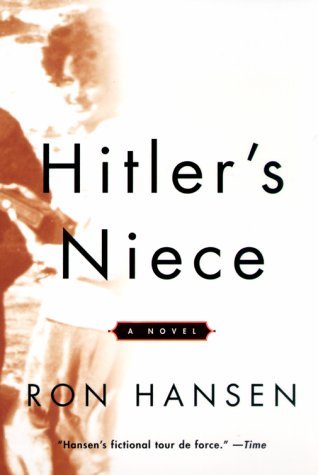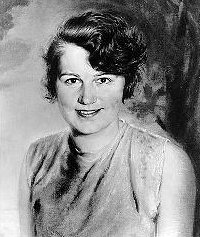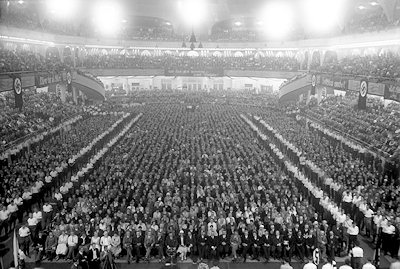Recommended.
The versatile novelist Ron Hansen strikes again. One change of pace after another from his ‘Mariette in Ectasy’ (1992) to ‘Isn’t it Romantic’ (2004), the first a study religious devotion in a turn of the century convent and the second a contemporary screwball comedy and this, an examination of the BEAST seen through the eyes of one of his very few relatives, a niece, the daughter of his half-sister.

It concentrates on the period between late 1919 and early 1930 and is based on biographical details spun by the novelist’s creative imagination into a tale of obsession, confusion, and demonic egotism. Hitler is almost human on occasion, but often playing a role to elicit the response he wanted from individuals at this early stage of his career: Pandering to some, bullying others, reasoning with a few, briefly avuncular.
I have never read anything about or by this the most famous man of the twentieth century, Adolph Hitler, so it was all new to me. The messianic self-confidence from the early 1920s that he WAS Germany (‘Du bist Deutschland,’ as Rudolph Hess always said), punctuated by lapses into exhaustion and doubt (human weakness) followed by a resurgence of manical energy charged with certainty.
The fulcrum of the novel is the niece Angela ‘Geli’ Raubal’s seduction by his aura, the prestige, and material wealth he increasing commanded with his periodic moods of sexual attraction to her and then revulsion from her. She became a canary in a gilded cage. Spoiled and then abused by turns, and at crucial moments lacking the will to break away when that might still have been possible.

Geli
This tension opens a window on Hitler, the man, through these crucial years. Hitler had at the start an iron self-control in public, and volcanic temper tantrums in private, but as his successes piled up, the line between public and private decayed for he discovered that he could get away with anything in public and still be hailed a genius. The temper tantrums were unleashed in his tirades.
Hansen gives us Rudolph Hess, Jospeh Göbbles, Hermann Göring, and others, all mesmerised by Hitler’s charismatic personality. ‘Charisma’ is a tried and trite word these days, and I try never to use it, yet there is no doubt it applied here. Hess and the others simply melt in Hitler’s presence, losing their wills and personalities.
The same applies to the thousands in the audiences of his harangues, though at a greater distance, they too are also compelled, lifted out of themselves by his exhortations. Hansen shows all of this, disgusting as it is, to be genuine, authentic. There is no cynical or instrumental calculation to explain their adherence, obedience, and the ensuing terrible deeds.
Long before he became Chancellor this man Hitler had a power over people that was tangible though invisible. There is the mystery at the core that continues to fascinate. After the explanations of time and circumstances are exhausted there is still that element left that defies conventional, rational explanation.
Yes, there were aristocrats, financiers, and industrial barons who thought they could manipulate this rabble rouser to combat the menace of communism, and then discard him, but they, too, as they drew nearer to him soon enough submitted to his will. Scenes in which Hitler seems almost deliberately to turn on his magnetic gaze — think Superman engaging his X-Ray vision — and bring to heel a millionaire, a full general, an heiress, a professor, a titan of industry, each his intellectual, organisational, or social superior yet all bowing down to this corporal without an education, with a grating Austrian accent, with a crude manner, spouting vitriol is …. astounding. There can be no other explanation but that word ‘charisma.’ The novel is a case study of that C Factor. (‘Charisma,’ for those who have not been paying attention.)
In David Fraser’s ‘Knight’s Cross: the Life of Erwin Rommel’ (1994, p. 433) there is an occasion when the war in July 1943 is going badly and Rommel, who had doubts about its conduct which as a good soldier he stifled, is scheduled to go to Berlin. This trip he welcomes because, he said, he would warm himself by the Füher’s radiance and gain re-newed confidence. It is a wistful, school-boy-with-a-crush kind of remark made by a decent, mature man who knew better and yet even he could not help himself. Rommel, like so many others, near or far, was hopelessly and helplessly in love with one Adolph Hitler.
There are many memorable scenes and events. Perhaps the best, for this reader, is the description of one of Hitler’s early speeches in an beer hall with an unruly crowd. Hitler is tight as a spring beforehand, nervous, angry, best avoided. He takes ten pages to the rostrum microphone in the hall, while the noisy crowd continues to drink beer and talk. ( We later learn that on each page is a bullet point in 10-15 words or so as a cue.) He begins…(after a few minutes the beer drinkers grow silent). The tirade mounts… (the beer drinkers lean forward to hang on every word). He continues … (the beer drinkers shout approval and applaud and he waves his hand and they fall silent like puppets on a string, this long before anyone even knew his name). HIs sermon becomes ever more explicit about what the problem is, what is to be done about it, concluding that Hitler alone sees the problem clearly and is willing to act on it with the merciless violence necessary to destroy the evils within Germany.

One crowd awaiting its master’s voice
He rants for more than two hours. The reaction is spontaneous and tumultuous. The beer drinkers rush to sign up for the Nazi Party. This is early in his career, there is nothing coerced about the response as would be the case later. He has jolted a nerve shared by members of this crowd – the western nations are eating Germany and Germans alive through their despicable agents the Jews, Jews and Communist are one and the same, wicked oriental cannibals, and the crowd’s response is galvanic. BANG! The poor, the uneducated, the impoverished veterans, dispossessed craftsmen, angry layabouts, the day labourers, the unemployed, the ignorant, these are the meek and they are being disinherited of their earth. For these, his is the voice. Hear it! Heed it! Obey it! (Christopher Isherwood says in this ‘Berlin Stories’ [1945] he went to a Nazi rally in 1938 and heard Hitler speak. Amid the shouting and frenzy he heard a familiar voice and turned to spot the speaker, only to realize it was he himself shouting his approval, even though he did not approve.)
After his speech Hitler is whisked away to a car out of sight. Sprawled on the back seat, he is drenched in sweat, reeking of vile emanations, exhausted, pale, his gaze unfocussed, twitching in throes, his clothes in disarray as if he clawed at himself. This description reminded me of Biblical accounts of John the Baptist channeling God’s will. It nearly killed John, but do it he must. Hitler, also, seems to be a messenger for something larger than himself. The agitator is himself agitated, as Harold Lasswell said all those years ago in ‘Psychopathology and Politics’ (1930).
Many were resistent to Hitler’s appeal like Geli herself who laughed in his face more than once.
Surprising to this reader was the cunning with which at times Hitler carefully tailored his message in the 1930 election so as not frighten voters. I had not credited him with that kind of calculation. But by that time, like the racism that infests contemporary American politics, it was so well embedded that it need not be said for it was communicated by signs and whispers. The red star of communism was also the Star of David. To attack communism was implicitly to attack Jews even if they were not mentioned.

Ron Hansen
False notes, there are a few. The most striking to me was the way Emile at the end seemed not to be bothered by Geli’s death.
Minor missteps? I wondered about the reference to a crossword puzzle in 1927 when the first crossword appeared in the ‘London Times’ in 1930, and the crossword being an Anglo-American invention it would have taken time to migrate to Germany. There is also a reference to a zinfandel-coloured carpet. I stopped at this, because the zinfandel grape skin is black and the use of it as a wine grape is American. (Yes, I know it has a long history and has been used in Croatia for centuries as a blender, but I doubt a German in 1927 would reach that far for a colour.) I also found jarring the reference to Kaiser rolls and Ferragamo shoes. The Kaiser roll is Austrian and may be named for a baker, not The Kaiser, and more generally called Vienna rolls. Salvatore Ferragamo started making shoes in Florence in 1927 and went bust in 1933, to be reopened in the 1950s, leaving me unsure that Geli could buy such shoes in a shop in Munich in 1930.
One contrast to Hitler of these pages is his contemporary Charles De Gaulle who also felt himself to be the saviour of his country and as a result grew a kingsized sense of his own importance, and yet he seems modest, even self-effacing in comparison. I read Jean LeCouture’s three-volume biography of Le Grand Charles years ago. De Gaulle did not use up people and then murder them when it was convenient as Hitler often did, like Ernst Röhm and perhaps Geli, among many others.
Skip to content
